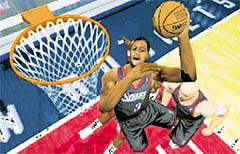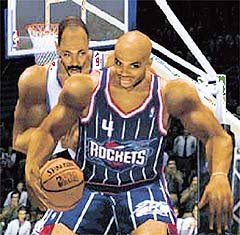May 10, 2000
GAME THEORY
Making Hoop Dreams Come (Almost) True
By MARC SPIEGLER
|


|
TELEREALISM
NBA 2K presents professional basketball as television
entertainment. A player can choose one of eight camera
angles to view the flashy offense or the more pedestrian
defense.
|
The National Basketball Association
was one of the marketing marvels of the 90's. So it is
no surprise that N.B.A. simulations have been a major
focus for video game makers, especially in an era when
motion-capture technology and high-speed rendering allow
the developers to offer nearly realistic games. Or rather,
"telerealistic" games, since television is the driving
medium behind the recent success of both the league and
the league-inspired games.
Many of today's basketball video games are licensed
N.B.A. products that feature full player rosters, with
images of the real athletes' faces skillfully mapped onto
their virtual bodies. At the top of this genre is NBA
2K, by Sega Sports for the Sega Dreamcast console.
Short of building in celebrity spectators and hordes
of photographers, every effort has been made to mimic
a televised event. The games start with laser-show introductions,
include a stream of cliché-ridden patter by the
television announcers for the Golden State Warriors, take
place in digitized versions of actual stadiums and even
include on-court woofing between players. When Kobe Bryant
pulls off a two-handed helicopter jam, for example, he
is prone to crowing, "I'm bustin' out the whuppin' stick."
To add to the telerealism, you can choose from eight
camera angles, including isolation cameras that track
a single character. Gamers can also call for a replay
at any moment. Using the console's controllers, you can
then watch the highlight frame by frame or freeze the
motion and swoop around the scene, recalling similar effects
in "The Matrix."
In actual game play, characters are impressively rendered,
their movements neither jerky nor truncated, and they
move around the court in an entirely plausible fashion.
The telerealism falls apart only in the close-up replays
triggered by players or by the game itself. That's when
the motions seem stiff and the players wear a single expression:
the patented sullen look of the professional athlete.
Only as their programmed shooting moves kick in do they
start displaying a wider range of facial expressions and
stop looking like doll heads on human bodies.
In fairness, that is a minor quibble, one that will
bother only players with unreasonably high standards for
the suspension of disbelief (and nit-picking critics).
Certainly, the game has a lot of what gamers call granularity,
those little details that make the action seem real. Would-be
coaches can call plays, change defenses and make substitutions;
fantasy-league devotees can trade players and even conduct
a full draft.
Game players with Dr. Frankenstein leanings can build
players from scratch, customizing things like height,
bulk and skills as well as facial hair, eyewear and sneaker
style. This character-making feature had one funny effect:
I built a player almost at random, then suddenly realized
that I had created a clone of Kurt Rambis, the gawky backup
center to Kareem Abdul-Jabbar during the Los Angeles Lakers'
"Showtime" era.
But once you get past all the razzmatazz, there is a
fundamental flaw in the game, one that has tripped up
the makers of every basketball game I have ever tried:
you just can't play good defense.
|
|
| Basketball with all the dazzle: no-look passes
and too-good-to-be-true dunks.
| |
|
|
Of course, that problem may be intractable. As anyone
who plays a team sport learns, the person playing offense
always has the distinct advantage of knowing where he's
going; the defender can only guess. That predicament is
compounded in video game play, where you can't watch your
opponent's hips or eyes, and where hitting a single button
will propel an offensive player toward the basket, but
adequately covering him requires a far more complex set
of moves. Because you can control only one character at
a time, you have to switch characters constantly as the
ball moves around the court, then move that man to the
ball quickly -- a tricky feat in the traffic of five-on-five
half-court offense.
That imbalance tends to make for riotously disjointed
games. On offense, you're pulling off plays you would
never attempt on a playground -- no-look passes, behind-the-back
dribbling, 360-degree dunks. And it takes only about three
attempts to learn the trick of successfully lobbing alley-oops
that lead to rim-crushing jams, an apparently unstoppable
tactic. Likewise, pushing the Turbo button while dribbling
upcourt tends to give you that extra quick step required
to shimmy behind your opponent for a layup.
Yet on defense, your character seems to be playing his
first game ever. If you want to win, you're usually better
off posting the man you actually control near the basket
to block layups and dunks, while letting the game's artificial-intelligence
programs handle the dirty work of actually guarding your
opponents. After a week of rigorous play, perhaps your
defense might become middling. But why bother, when you
can be competitive against the computer without even learning
to play solid man-on-man?
Without good defense, NBA 2K quickly becomes an exercise
in shame, as Rusty LaRue, the Bulls journeyman, grandstands
his way up the court after dunking over Glen Rice, the
Los Angeles Lakers All-Star (or, at least, over your sorry
attempt to play as Rice). The game has a practice mode
for passing and shooting, but not for defense. That is
especially disheartening because of NBA 2K's arsenal of
programmed offensive stunts.
One could argue that this is only fitting, given how
much of today's N.B.A. play revolves around making the
evening sports newscast with acrobatic slams and fancy
dribbling moves. And it is precisely the realism of those
components that makes NBA 2K such an exciting game to
play; there's no telling what wonder you'll pull off next.
Still, it's defense that wins real basketball games. As
long as virtual hoops draws more on the legacy of the
flamboyant dunkmeister Darryl Dawkins than the fundamentals
fanaticism of the great U.C.L.A. coach John Wooden, there
is some critical realism sorely missing. Then again, it's
just a video game -- cue the highlight reel.
NBA 2K by Sega Sports for Sega Dreamcast; $39.99;
for all ages.

